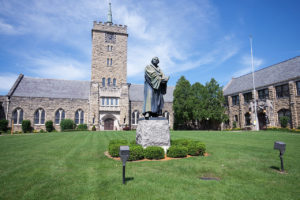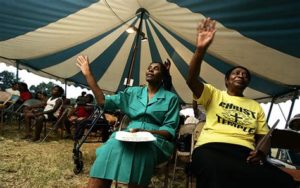I. Our Need (Continued)
Solutions offered
One major solution to the instability of African churches is to develop trained pastors, since the majority of churches are still without one (both in Africa and worldwide) (Buys, 2002a)4. But training such pastors becomes difficult when there are few local churches mature enough to raise up qualified candidates and to apprentice them and model for them what biblical principles look like in practice. Rare is the seminary or college that can offer what a strong local church can in terms of integrated (theory, practice, and supervision) training. Studies also show that graduates who return to unstable churches often face such inertia that they never effectively implement change (Stamoolis, 2001:489).
Any diagnosis of these un-established churches must go beyond the obvious need for leaders. Mission groups must not only ask, ‘After a church is planted, then what?’ More must start asking, ‘How should a church be planted and nurtured to maturity until qualified local elders are entrusted with leadership?’ (Patterson, 1999:595-605). The lack of qualified pastors in churches is  often only a symptom of the root problem: deficient church planting. In fact, a multitude of problems in the African church and society can be traced back to the planting of weak, ineffective churches. Just supplying more pastors or more churches is not the most effective solution, and it could even increase the problem.
often only a symptom of the root problem: deficient church planting. In fact, a multitude of problems in the African church and society can be traced back to the planting of weak, ineffective churches. Just supplying more pastors or more churches is not the most effective solution, and it could even increase the problem.
But once the core problem of church health is addressed, many other symptoms will recede. Better churches produce better people, better leaders, better marriages, better parents, a better workplace and a better society. The need for stronger churches in Africa is the ‘longest pole in the tent,’ the one issue which affects every other issue, the one solution upon which all other solutions will depend.
A case study – BUSA
One African denomination that is facing many of these challenges is the Baptist Union of Southern Africa (BUSA). BUSA has seen both rapid growth and need for depth. In BUSA, we are seeking to find solutions to strengthen churches so that we can also pave the way for other African denominations that face similar challenges. Time and again I have witnessed the instability of African churches in our work at Christ Seminary in Polokwane. Over the past six years, I have visited many young churches and have seen firsthand their dire needs for nurture. I have also spent hundreds of hours in discussion with the leaders of these young churches and have heard of the challenges they face because they were not well established at the outset.
Since 1990, BUSA claims that 413 new churches have been started (Rae, 2003), which has more than doubled the size of the denomination (Robbins, 2003:157; Rae, 1999:164). Adding up other BUSA statements yield smaller, but still significant figures: 376 or 335 new churches (since 1990) (BUSA Handbooks, 2002 & 2003a; Rae, 2001:7). The BUSA president for 2002-2003 has said, “A new BUSA church is planted every thirteen days” (Coertze, 2003). A recent ecumenical publication on mission in post-apartheid South Africa highlights the BUSA as an example of effective church planting (Kritzinger, 2002:58; Robbins, 2003:157). But in order to deserve such praise, the BUSA’s proof must not be in just the numbers but in the quality of the churches being planted. Since these new churches represent over half of the BUSA, the health of these churches has serious bearing on the overall health and direction of the entire union.
The BUSA has acknowledged the lack of depth in many of its new churches, and has begun giving attention to nurturing them.  For nine years, the BUSA had a General Secretary whose main burden was for more church planting (“95 [new churches] by 1995” and “201 by 2001”; Rae, 2003; Rae, 1999), which had been underemphasized in previous years. Now the current BUSA General Secretary, Rev. Scheepers, has brought a timely vision for strengthening these churches. This has been signalled by his thrust, called “Equip 2005”, which has generated helpful training manuals for the churches, along with workshops for the
For nine years, the BUSA had a General Secretary whose main burden was for more church planting (“95 [new churches] by 1995” and “201 by 2001”; Rae, 2003; Rae, 1999), which had been underemphasized in previous years. Now the current BUSA General Secretary, Rev. Scheepers, has brought a timely vision for strengthening these churches. This has been signalled by his thrust, called “Equip 2005”, which has generated helpful training manuals for the churches, along with workshops for the
church planters (BUSA Handbook, 2002:210).
Furthermore, this year Rev. Scheepers is launching “Impact 2010”, with a slogan calling us to “reach and disciple,” to “plant and to nurture” churches. This is an exciting emphasis on greater church-strengthening. The head of BUSA missions, Dr. Eric Robbins, also wrote, “Following the phenomenal growth of BUSA in recent years there is obviously a great need for discipleship, teaching, and consolidation of the work” (2003:157). Rev. Scheepers has said that he thinks the BUSA needs an entirely “new model” for quality church planting (2004). At Christ Baptist Church where I minister and where many churches have been planted or assisted over the past fifteen years, we too feel this critical need to strengthen weak church plants and improve church planting.
My research
It was because of these concerns in the BUSA and in our ministry up in the Limpopo Province that I embarked on doctoral research to see how we could improve the situation. I surveyed the leaders of about 250 of the churches planted since 1990, and I heard back from eighty-three of them. I combined this with many interviews of area coordinators and key church planters. If I had the space, I could mention many of the highlights and strengths in these zealous young churches. But in line with the purpose of this article, let me list some of the chief concerns that surfaced in this research:
• Over a third of these churches is being pastored by ‘remote control’. In other words, their pastor does not stay locally with their church, but either travels there on Sundays or weekends, or only goes two Sundays or less per month.
• Less than half of these pastors believe that preaching verse-by-verse through God’s Word is the best regular food for their flock. Over half said they’d rather choose what to preach along more subjective guidelines or just preach evangelistically.
• Less than one-third of these younger churches acknowledged any link with a mother church.
• Over half say their giving/tithing has shown no increase in the past two years (and what they are getting is tiny in most cases, far from being enough to live on).
• Only one-third of these pastors said he was sure that the majority of his members have a good grasp of the gospel.
• These churches have been in existence for an average of nine years, yet the average increase of adult members over those nine years is only eleven new members in total (they started at an average size of 20 and are now at an average size of 31 members). This would suggest that they are averaging about 1 new member added each year (about a 5% growth rate).
• The combined opinion of the area coordinators and numerous other key church planters and leaders is that only 20-25% of
these churches have become healthy or mature, responsible churches (even though these churches are an average of 9 years old by now). These same observers also estimated that just over half of these churches still do not have a capable pastor or leader who has received or is receiving some kind of adequate training (even if it is non-formal).
• Many of us who have spent time in some of the newer BUSA church plants in the Limpopo Province have noticed certain patterns: the tent evangelism draws many more decisions than real, lasting disciples, and it tends to attract mostly women, youth, and children (which doesn’t form a good long-term backbone for a church); there is a severe lack of men and of whole families; there is a lack of good leadership; there is weak or shallow teaching of the Word; there is a strong charismatic influence and reliance on emotion over truth; these churches are often crippled by a dependency mentality (waiting for outside funding) and a lack of real responsible ownership for the ministries and the mission of the church.
This brings to my mind the rebuke given by one contemporary missiologist (Reed, 1992:138, 143): “One of the great indictments of colonial [and modern] missions is its consistent failure to establish associations of independent, thriving, and reproducing churches, filled with real leaders, able to think theologically in their own culture”. An African proverb says, “You can never abandon your own born child”. Yet I fear that too often this is exactly what we do in church planting, leaving crippled infant churches by the wayside as we rush off to the next church plant.
Yes, obviously there are many other socio-economic and cultural factors that have contributed to the instability of these churches. But most of those factors are out of our control; and, these factors cannot be blamed for all the problems in these churches. So it is more helpful and more hopeful to focus on what we can do to improve the stability of these churches.
 – Tim Cantrell, President and Professor of Systematic Theology, Shepherds’ Seminary
– Tim Cantrell, President and Professor of Systematic Theology, Shepherds’ Seminary

